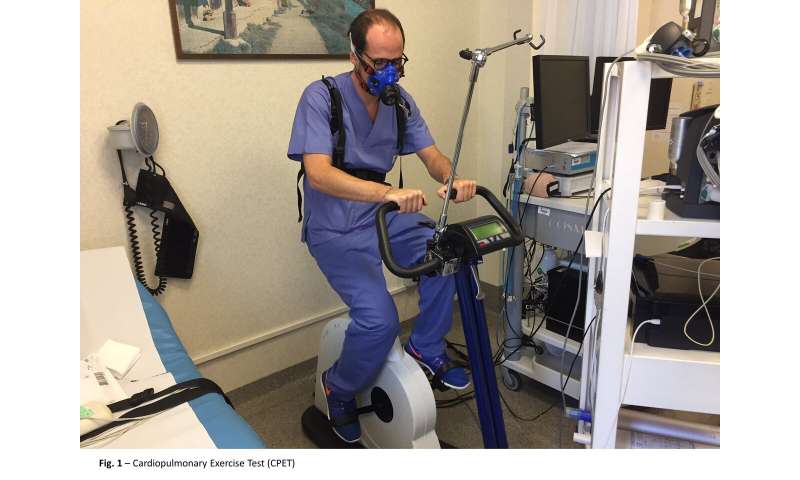
Wearing a protective face mask has only a modest effect on the ability of healthy people to do vigorous exercise, according to a study published today in the European Respiratory Journal.
Researchers carried out detailed testing on breathing, heart activity and exercise performance in a group of 12 people while they were using an exercise bike with and without a mask.
Although they found differences in some measurements between wearing a mask and not wearing a mask, they say that none of their results indicate any risk to health. This suggests that masks could be worn safely during intense exercise, for example to reduce COVID-19 transmission between people visiting an indoor gym.
The study was by a team of researchers including Dr. Elisabetta Salvioni from Centro Cardiologico Monzino, IRCCS, Milan, Italy, and Dr. Massimo Mapelli and Professor Piergiuseppe Agostoni from Centro Cardiologico Monzino and the University of Milan.
Dr. Salvioni said: “We know that the main route of transmission for coronavirus is via droplets in the breath and it’s possible that breathing harder during exercise could facilitate transmission, especially indoors. Research suggests that wearing a mask may help prevent the spread of the disease, but there is no clear evidence on whether masks are safe to wear during vigorous exercise.”
To address this question, researchers worked with a group of healthy volunteers made up of six women and six men with an average age of 40. Each person took part in three rounds of exercise tests: once while not wearing a face mask, once wearing a surgical mask (blue, single-use mask) and once wearing a ‘filtering face piece 2’ or FFP2 mask (white, single use mask believed to offer slightly better protection than a surgical mask).
While the volunteers used an exercise bike, the researchers measured their breathing, heart rate, blood pressure and the levels of oxygen in their blood.
Results of the tests showed that wearing a face mask had a small effect on the volunteers. For example, there was an average reduction of around ten percent in their ability to perform aerobic exercise (according to their ‘peak VO2’ which is a measurement of their highest possible oxygen uptake).

The results also indicate that this reduction was probably caused by it being slightly harder for the volunteers to breathe in and out through the masks.
Dr. Mapelli said: “This reduction is modest and, crucially, it does not suggest a risk to healthy people doing exercise in a face mask, even when they are working to their highest capacity. While we wait for more people to be vaccinated against COIVD-19, this finding could have practical implications in daily life, for example potentially making it safer to open indoor gyms.
“However, we should not assume that the same is true for people with a heart or lung condition. We need to do more research to investigate this question.”
The team are now studying the impact of wearing a face mask while carrying out daily activities, such as climbing the stairs or doing housework, in healthy people and those with heart or lung conditions.
Professor Agostoni added: “COVID-19 has hit our region and our hospital so hard, with devastating effects at a personal, professional and organisational level. Despite that, this was one of many studies carried out with enthusiasm by our young researchers.
“We are particularly proud of this work because it began spontaneously during our free time in the otherwise depressing period of the current pandemic and our findings demonstrate the necessity of clinical research, even during an emergency.”
Professor Sam Bayat from Grenoble University Hospital, France, is Chair of the European Respiratory Society (ERS) Clinical Respiratory Physiology, Exercise and Functional Imaging Group and was not involved in the research. He said: “There are still gaps in our knowledge of how to limit the spread of COVID-19, but we believe face masks have a role to play and we are becoming accustomed to wearing face masks in public spaces such as shops, trains and buses.
Source: Read Full Article